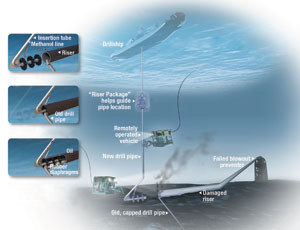The rig owner is claiming progress on capping a deepsea well gushing oil into the Gulf of Mexico, but, as Louisiana Gov. Bobby Jindal (R) said on May 17, “We are nowhere close to the finish line. This disaster will not be over for Louisiana until our water and our shores are completely clean and our wildlife, our communities and our coastal industries are 100% restored.”
BP, owner of the Macondo well that has been gushing oil into the gulf since the drilling rig Deepwater Horizon exploded and sank April 20, says it succeeded, on a second try, in inserting a 4-in-dia drill pipe into a 21-in.-dia riser that is one of two sources of the spill. BP says the inserted tube is capturing about 1,000 barrels per day of a flow it estimates at 5,000 bpd, or 210,000 gallons per day. A growing number of researchers dispute that figure, however, and say the flow may be as large as 4.2 million gallons per day.
Flow from a second leak, at the wellhead, is not affected by the inserted tube.
In Washington, D.C., the White House on May 12 sent Congress a legislative outline to strengthen the response and recovery effort. The package would raise the cap on damages and claims to $750 million from $500 million and increase the amount of Oil Spill Liability Trust Fund money that can be expended per incident to $1.5 billion from $1 billion. The outline also calls for raising liability caps for responsible parties, although it does not specify an amount.
White House officials, feeling public pressure, want to fast-track the measure, calling for a vote within weeks.
Gov. Jindal also is pushing the U.S. Army Corps of Engineers to launch a huge, emergency beach renourishment program to beef up many low-lying barrier islands and create a “sand boom” to protect coastal wetlands.
“We presented this plan almost two weeks ago because we expected to need greater defenses than booms on the top of the water,” Jindal said. “We are very concerned about reports of oil submerged under the water.”
If permits are approved, Jindal says, “We could start to see land or ‘sand booms’ in place in around 10 days. We need to get this plan moving as quickly as possible.”
Corps chief Lt. Gen. Robert L. Van Antwerp Jr. says part of the proposal to build up and link the now partially submerged Chandeleur Island chain has been planned in Plaquemines Parish for years, and he endorses it. He also says there are dredges nearby that could start as soon as permits are in place. If U.S. resources turn out to be inadequate for a big, rapid push, he says, the Jones Act, which now bars foreign dredges from helping, could be temporarily waived.
At the well, Doug Suttles, BP’s chief of operations for American exploration and production, says the newly inserted tube may ultimately capture more than half the oil from that part of the leak. The captured oil is flowing up to a drillship that can process 15,000 bpd and store 139,000 barrels. Natural gas is being flared. BP also is planning to try a “top kill” in seven to 10 days. This involves forcing mud and debris into the well to clog it up.
The firm will use a manifold to connect pipes and hoses to the well’s line below the blowout preventer, which is the shut-off device that failed on April 20. BP will use 30,000-hp pumps to inject as much as 40 barrels of mud per minute to counteract the pressure of the oil flow. “It’s about us outracing the well,” says Kent Wells, a BP official.
If the mud and debris works, BP then will pump in drilling concrete in to seal it. A relief well will be drilled to finish the closure. Suttles says the well will never be reactivated.





Post a comment to this article
Report Abusive Comment